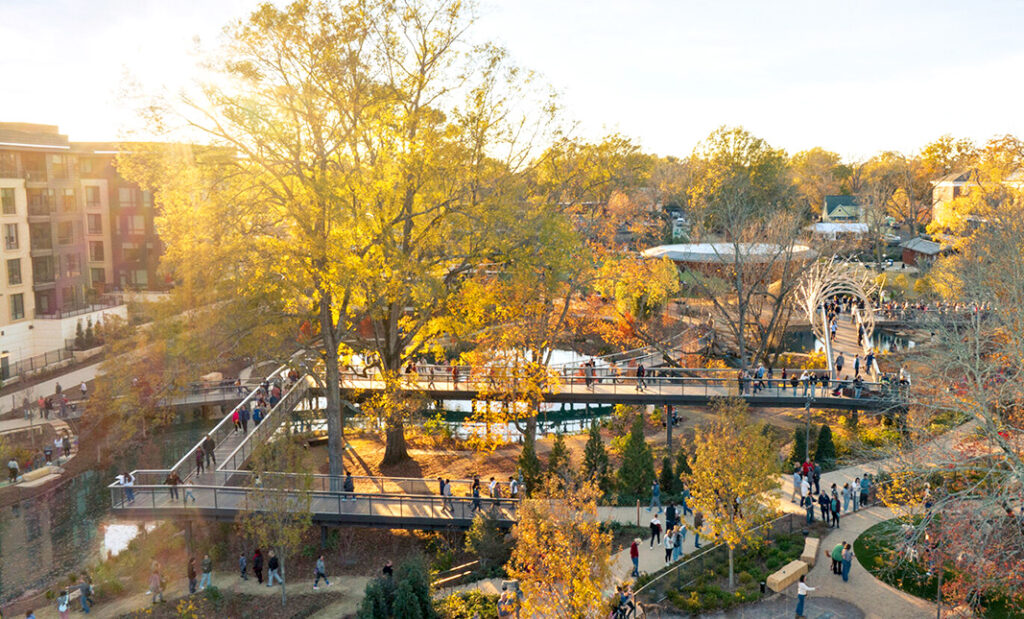Top: Aerial photo of Downtown Cary Park (North Carolina), which used various green infrastructure strategies in its construction. Photo OJB Landscape Architects, Boston and inset by Ron Alexander
Ron Alexander
In 1991, my wife and I moved from southeastern Pennsylvania to Cary, North Carolina, located in the Capital (Raleigh) region of the state. I had been running a landscape materials company that was one of the first to market commercially manufactured compost in bulk form to the landscaping industry. We had already worked with hundreds of landscapers, turf specialists and landscape architects on improving the structure of heavy, fine-textured soils with compost, making them more suitable for use as functioning landscape grade soils. We had also worked with some forward minded landscape architects and soil specialists to use compost in developing engineered soils for intensive planting areas, athletic fields and green roofs.
We left behind southeastern Pennsylvania’s heavy silty and clay-based soils for the Raleigh area, which possesses perhaps even denser red clay soils (Ultisols). When we left Pennsylvania in 1991, the commercial composting industry had already established itself, and compost was beginning to be seen as a great tool to improve the structure of fine, dense soils that are so easily compacted, morphing them into much more versatile landscape grade soils. Today, compost is seen the same way in North Carolina and pretty much anywhere in the U.S. landscaping industry. Commercially manufactured compost is understood to be a high-quality form of stabilized organic matter, which possesses great soil building properties, including improving water holding capacity, permeability and aggregation. Many composts also can naturally suppress certain soil-borne plant diseases, as well supply important carbon and humic substances to help in the mitigation of climate change.
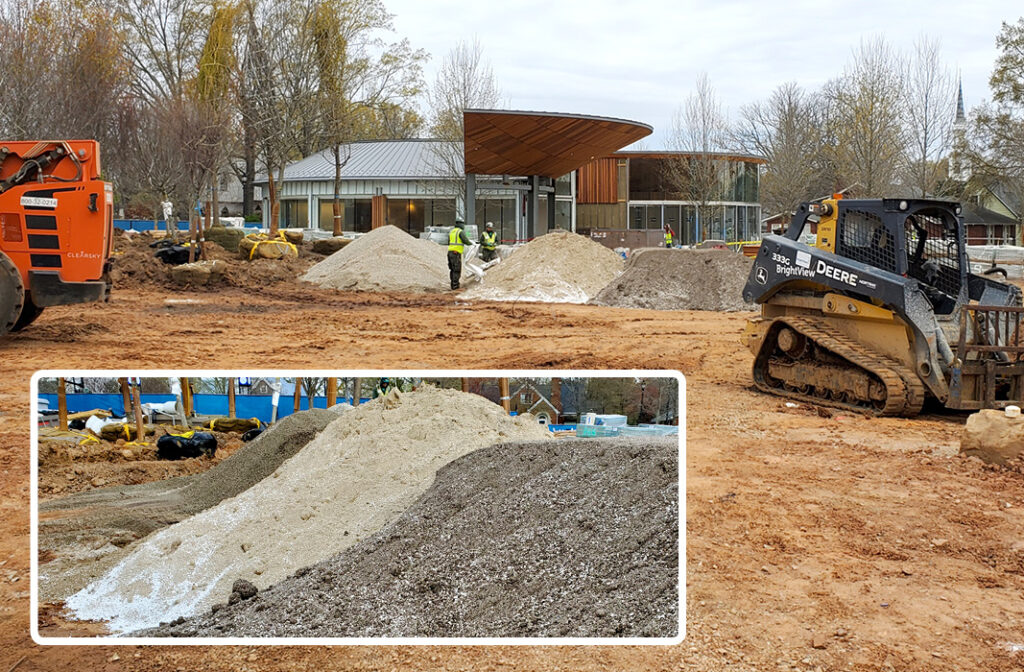
Dense, clay-based soil native to the Piedmont region of North Carolina was improved with engineered soils containing compost for planting areas and bioretention features (inset). Photo by Ron Alexander and inset courtesy Wade Moore Equipment
Fast forward 10 years (2001) when Cary’s forward-minded Town Council approved the Town Center Area Plan, which included a proposed Town Center Park that would act as a visual and focal point for its downtown. In 2013, Cary’s Town Council adopted the Downtown Park Master Plan and Town Square design and later determined that the planned downtown park would be 7 acres in size and adjacent to a new town library (and parking deck). The overall project would be developed in phases, with street improvements and the Town Square being completed in 2017 and the Cary Regional Library and parking deck (also providing parking for the park) being completed late in 2019. In 2018, the Cary Town Council selected OJB Landscape Architects (Boston) to update the Master Plan for the “Downtown Cary Park” Project. The park, which cost $69 million, opened to the public in November 2023.
Tree Preservation
The park features a “Great Lawn,” beautiful and purposeful water features, a pavilion for performances and indoor spaces to host events and classes. It is no surprise that with central North Carolina’s hot and humid summers, Cary residents felt that a priority needed to be placed on maintaining and/or establishing a strong tree canopy wherever possible in the park. The Town of Cary’s arborist and related contractors provided assessments of the health and life stage of all 74 trees on the site and found that some were healthy and vigorous, while others were in decline due to flooding, compacted soil, and other issues, according to Doug McRainey, Community Project Director with the Town of Cary. While some older established, but declining, site trees were removed during the development process, 36 large legacy trees were retained including large oaks, pecans, river birches and Loblolly pines, located in three zones of the park. Some of the trees removed were even made into benches placed throughout the park.
To better protect the remaining legacy trees, large fenced off protected areas were established and maintained during the life of the project, which did not always make construction activities efficient. These trees were pruned as necessary to improve their health and allow them to better fit into the site design. Also, to invigorate them and help them bounce back from construction activities, air-spading of the soil inside the entire tree protection zone was completed to a minimum depth of 6-inches. The area was then topdressed with a 3-inch layer of a compost/sand blend, which was incorporated into the loosened air spaded soil. The yard trimmings compost used on the entire project was manufactured by the neighboring City of Raleigh. Branded Raleigh Organic Compost, the product is certified by the US Composting Council’s Seal of Testing Assurance program and is OMRI-listed for use in organic agriculture and horticulture.
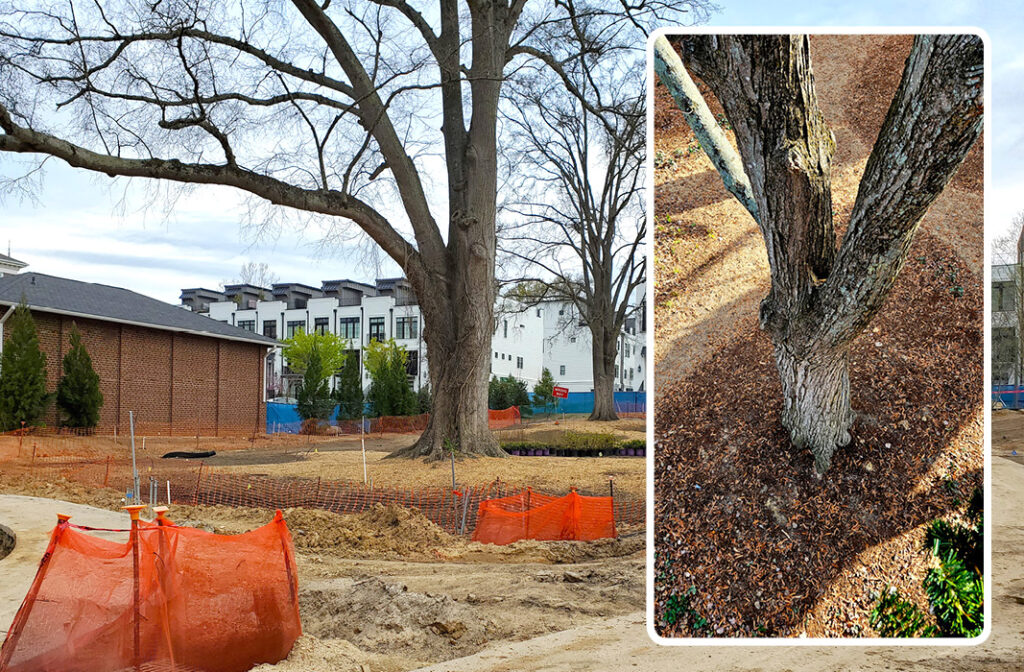
Existing (legacy) trees were protected during construction activities and invigorated with air spading and the application of a compost/sand blend (inset). Photos by Ron Alexander
Air spading can improve tree health and stimulate root system growth by reducing soil compaction, thus making it easier for trees to access water, nutrients and air, while improving drainage. Further, adding a high-quality compost-based topdressing provides slowly releasing nutrients to the trees and organic matter (carbon) to feed soil microbes and improve soil aggregation. These soil improvement activities were seen as vital to improve the compactable local soils, which do not easily accept and percolate precipitation from moderate or heavy rainstorms.
“Town arborist staff were involved in new tree and plant selection for the project, as well as turf selection and design of the Great Lawn engineered soil,” notes Joy Ennis, Parks General Manager, Town of Cary. Huge planting areas were established throughout the park using 66,000 well-sized plants that provided immediate visual enhancement to the park. To augment tree, shrub and plant establishment, engineered soils were specified for use in all of the planting areas. New plantings included 600 native and adaptive tree species that added to the park’s canopy, creating shade areas and expanding the urban forest, while enhancing overall beauty and animal habitat. Species variety was also considered as a means to better protect the park tree community against pest and disease pressures. As noted on Cary’s website, “these new trees will create an environment that is significantly more forested than previously existed. This ensures that rainwater is absorbed during intense storms, carbon is sequestered to improve air quality, and impacts of high temperatures are buffered by the resulting ecosystem.”
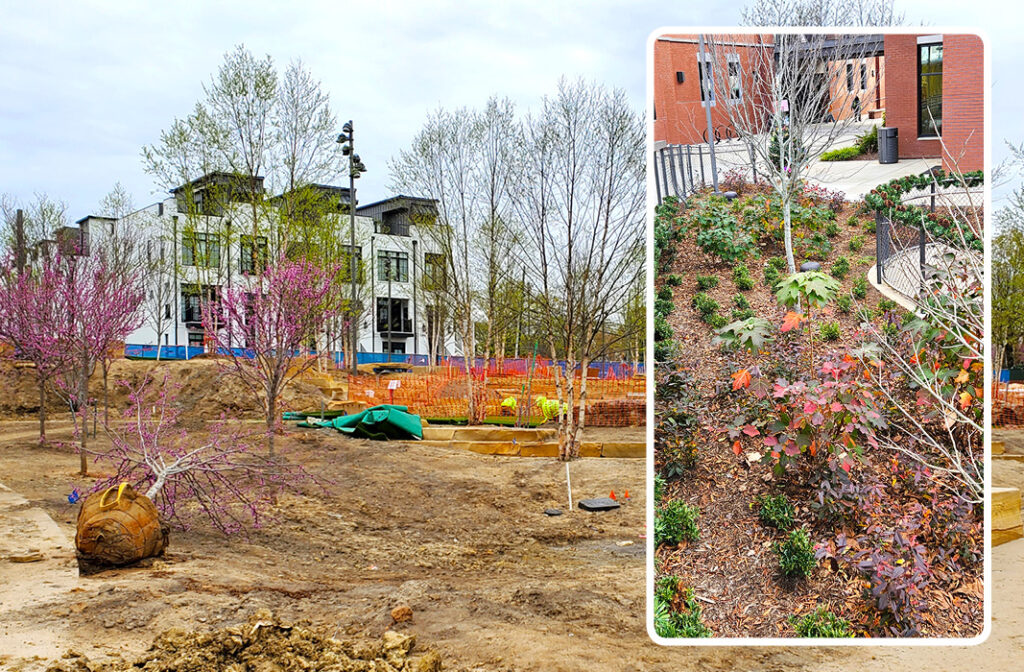
New planting area for trees and shrubs (inset), established in engineered soils containing compost. Photos by Ron Alexander
The engineered soils were supplied by Wade Moore Equipment, a sand, gravel and custom soil producer located an hour north of the project site. “The planting soil mix was also designed to accept and percolate water (1.5-inches per hour, minimum), as a means to reduce storm water runoff when intense North Carolina rainstorms occur,” explains Brandon Seiffert, Wade Moore Equipment’s project manager. “This same soil is rich in organic matter (5-7% organic matter target) so the Town can reduce supplemental irrigation.” A variety of planting soil mixes were designed for the project, but the primary mix used in the planting beds contained equal parts of sand, sandy loam soil, and Raleigh Organic Compost. The rain garden bioretention soils contained 5 parts sand, 1.5 parts sandy loam soil and 3 parts compost (on a volume basis).
Enhancing Green Infrastructure
North Carolina has been ranked as one of the top 10 most climate change impacted U.S. states. Insurance companies have ranked states based on risk related to coastal flooding, inland flooding, drought, extreme heat and wildfires. In the Capital region of North Carolina, the most significant risks relate to inland flooding, drought, and extreme heat. Factors that contribute to inland flooding are intense and high-volume rain events, dense soils (and/or too little greenspace), and insufficient storm water infrastructure. The Downtown Cary Park design and infrastructure tries to address several climate change related concerns. The park has installed smart irrigation (watering informed by weather and/or soil moisture data) throughout the Great Lawn and drip irrigation in the planting beds, as well as around the older established trees to help manage ongoing water requirements and better deal with summer drought conditions. As noted earlier, the large amount of tree canopy helps visitors better manage extreme heat conditions while in the park. Also, with the sheer volume of trees and plants established in the park, their normal respiration should work to reduce site temperatures. Finally, the park’s design takes into account both the increased intensity of regional rain events and the need to improve overall drainage and water quality in older areas of the Town of Cary, including the downtown.
With this effort, Cary is following a national trend where new parks and public areas are designed with a dual purpose — creating space for leisure activities and to provide visual appeal, and to incorporate infrastructure capable of managing not only site storm water, but also storm water from adjacent properties. The techniques being used reduce flow volumes, mitigating downstream flooding, as well as incorporating vegetation to filter and remove sediment (and pollutants attached to it).
While the Downtown Cary Park utilizes various green storm water management devices, such as dry riverbeds, bioswales and rain gardens, the major storm water management feature in the park is its pond system. The areas around the dry riverbed are planted (vegetated) and use an engineered rain garden type media (sand, compost and soil-based media to filter the water) that can improve water capture and percolation. The riverbed and sidewalls are covered in rock to slow water velocity when containing water and help protect against erosion. The water features in the Downtown Cary Park act as visual amenities and natural habitats but can also mitigate runoff from a 500-year storm event. Using the park’s 30-foot drop in vertical grade, a three-tiered storm water management system was developed to try to mimic natural storm water systems which can manage and infiltrate large volumes of water, while reducing sediment and its associated pollutants, enhancing water quality. The uppermost area of the park uses a smaller pond and the meandering dry riverbed to capture rainwater, which feeds into a middle (downgrade) pond that assists sediment capture. The water then cascades over a natural looking stone weir which aerates the water before it enters the largest pond further downgrade. This ”waterfall” generates the sounds of a calming babbling brook.
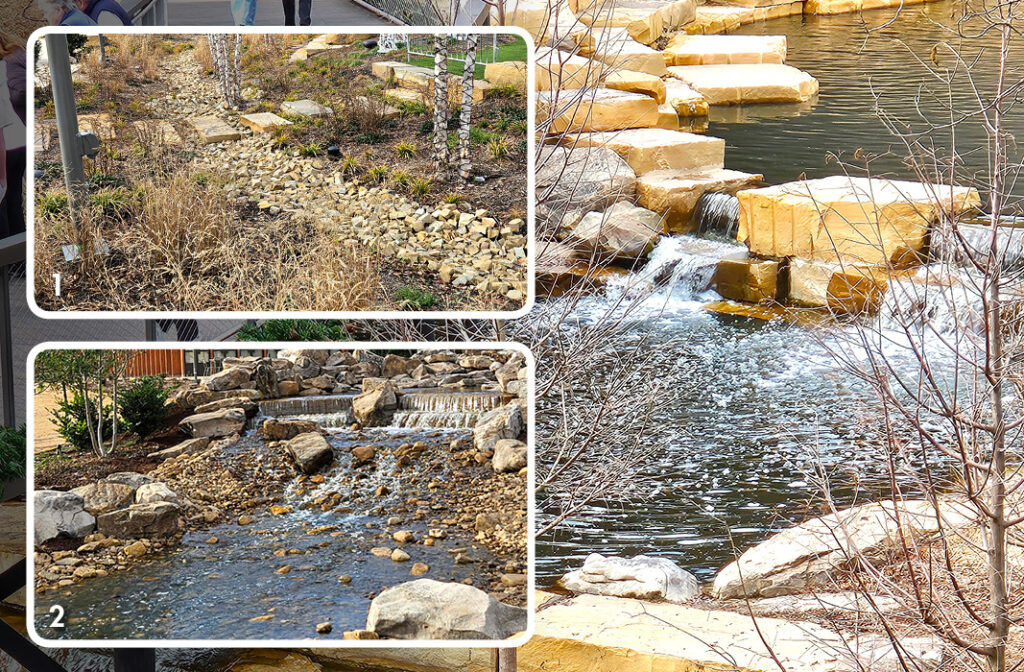
Dry riverbeds (inset 1) were developed for storm water management and waterfalls (inset 2) created for beauty and storm water treatment. Storm water is shown (on right) moving from the secondary pond to the lower pond.
“The large lower pond provides detention to mitigate flooding in downstream neighborhoods and water quality treatment to filter out nutrients,” notes McRainey with the Town of Cary. “To provide additional water treatment during a storm, a separate underground filtration system (and storage tank) is engaged as overflow water leaves the pond.” In addition, the outlet to the lower pond can regulate the flow discharging downstream, by circulating water back to the upgrade storm water features in the park, for further treatment.
The Downtown Cary Park is an excellent example of what can be created using a pragmatic, inclusive and collaborative approach to planning and design by taking into account developing a highly trafficked park in a region which possesses dense finely textured soils. It provides the Town with a means to collect and treat storm water within a vital urban watershed, using green infrastructure and recycled products (compost). To encourage more projects like these, the US Composting Council is working with the American Society of Landscape Architects to develop a tool that will examine the climate benefits of establishing healthy (organic matter-rich) soils on landscaping projects. “We applaud the Town of Cary’s visionary investment in this type of public infrastructure as a critical foundation for the future growth of their downtown,” says Cody Klein with OJB Landscape Architects. “This will be a park for the community, based on the community’s aspirations, for generations to come.”
Ron Alexander is president of R. Alexander Associates, Inc. (Apex, North Carolina, www.alexassoc.net, a company specializing in product and market development for organic recycled products. He is author of ”The Practical Guide to Compost Marketing and Sales” (2nd Edition published by BioCycle) and has over 40 years of experience in compost and recycled organics product marketing. Mr. Alexander is a member of the US Composting Council’s Seal of Testing Assurance (Program) Advisory Committee and is an Industry Liaison to AAPFCO (Association of American Plant Food Control Officials).



